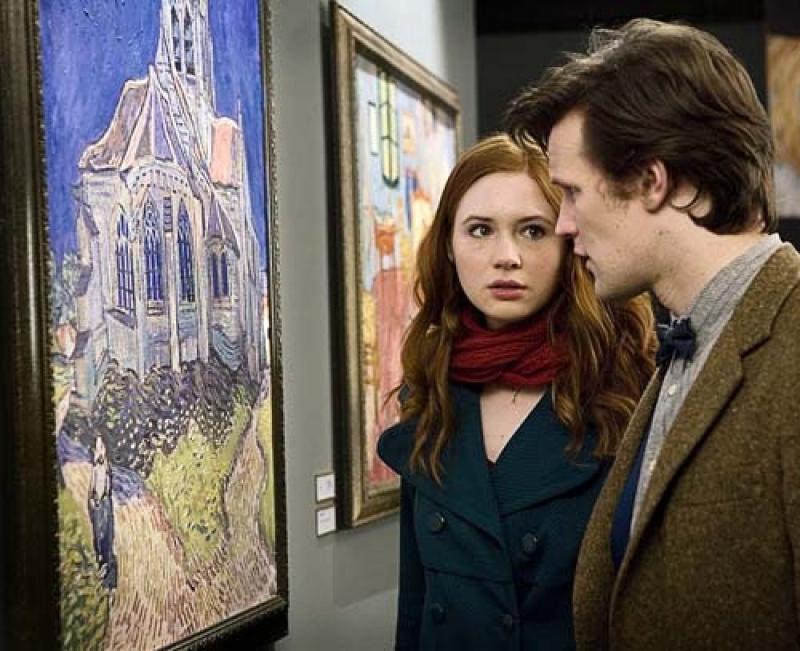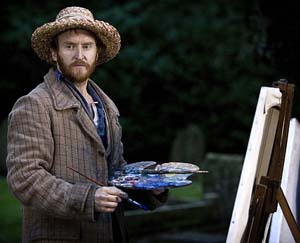Doctor Who: Vincent and the Doctor, BBC One | reviews, news & interviews
Doctor Who: Vincent and the Doctor, BBC One
Doctor Who: Vincent and the Doctor, BBC One
The Doctor tries to rescue Van Gogh from his demons, real or imagined

The Doctor Who crew are fond of their encounters with historical characters. In his time, and let's face it he has infinite supplies of it, the Doc has rubbed shoulders with Shakespeare, Charles Dickens and Agatha Christie, and recently weathered the Blitz with Winston Churchill. For this one, "Vincent and the Doctor", le Docteur voyaged back to 19th-century Provence to straighten out a puzzling temporal kink.
While visiting the Van Gogh exhibition at the Musée d'Orsay in Paris, where art historian Dr Black (Bill Nighy) was holding forth about the marvels of the tormented Dutch genius, the Doctor (Matt Smith) noticed a sinister demon lurking in Van Gogh's painting of the church at Auvers. The Doctor's uncanny intuition told him that something was awry, so he was off to fire up the Tardis, his assistant Amy (Karen Gillan) in tow.The Doctor Who crew are fond of their encounters with historical characters. In his time, and let's face it he has infinite supplies of it, the Doc has rubbed shoulders with Shakespeare, Charles Dickens and Agatha Christie, and recently weathered the Blitz with Winston Churchill. For this one, "Vincent and the Doctor", le Docteur voyaged back to 19th-century Provence to straighten out a puzzling temporal kink. While visiting the Van Gogh exhibition at the Musée d'Orsay in Paris, where art historian Dr Black (Bill Nighy) was holding forth about the marvels of the tormented Dutch genius, the Doctor (Matt Smith) noticed a sinister demon lurking in Van Gogh's painting of the church at Auvers. The Doctor's uncanny intuition told him that something was awry, so he was off to fire up the Tardis, his assistant Amy (Karen Gillan) in tow.
This episode had gathered a bit of extra buzz by being written by Richard Curtis, rom-com supremo and TV's Mr Charidee. The Doctor must have been relieved to find that he wasn't being made to abolish famine in Africa, do comedy sketches with the Daleks and then marry an American movie star, but it didn't feel as though Curtis was entirely comfortable in this alien environment. It can't be easy to parachute in a one-off contribution to such a national institution, and Curtis has freely admitted that the producers told him to go away and have another try after they'd seen the first draft of his script. Two or three more might have been advisable.
It was the whole "monster" aspect that stuck out like a refrigerator bolted to a bicycle. Arles, 1890, was being terrorised by an unknown beast which was slaughtering the local girls. Unknown, that is, to everyone except Van Gogh (Tony Curran, with unreconstructed Scottish accent, pictured below), whose extraordinary synaesthesic gifts meant that he alone could see the unprepossessing parrot-dinosaur thing (a Krafayis, to give it its proper title) roaming the backstreets or stomping around in his back garden. But nobody was taking much notice of Vincent ("he's drunk, he's mad and he never pays his bills", grumbled the local inn-keeper), until the Doctor arrived and engaged in a bit of rough-and-tumble with the Krafayis himself.
Resisting the temptation to have the Krafayis rip Vincent's ear off, which might have been taking the idea of the space monster as the embodiment of his inner demons a little too far, Curtis was chiefly preoccupied with the painter's mental anguish and the way this was transformed through his work. Themes from Van Gogh's paintings had been recreated with imagination and technical skill, including a brilliant evocation of Cornfield with Crows and an ingenious real-world rendition of The Starry Night. Exteriors of the Provençal countryside looked ravishing, despite having been shot in Croatia.
 Evidently Curtis wanted to create a sincere homage to Van Gogh, but was it wise to jam it into the unsuitable framework of Doctor Who, which vacillates confusingly between sci-fi, soap and comedy? The Krafayis was really a canard, despite Curtis's attempt to make us feel sorry for it because it was blind, lonely and frightened (which jarred against the Doctor telling us that it was from a pack of murderous intergalactic predators). There was some drollery when the Doctor was trying to identify the Krafayis from Van Gogh's sketch but kept getting false matches ("That's the problem with the Impressionists, not accurate enough"), but the seams began to gape when the Doctor transported Vincent to 2010 to show him how celebrated his work would become. Vincent's self-destructive urges were assuaged by a eulogy to his work from Nighy's Dr Black ("the greatest painter of them all... unique beauty", etc), and Amy felt certain that this foreknowledge would free Vince to create yet more easel-tastic splendours. Sorry, art lovers, it didn't happen. He still committed suicide in July 1890, depressed and dismally unsuccessful. And the point of all this was... um... not entirely clear. Except that Vincent had added the dedication "For Amy" to Vase with Twelve Sunflowers. Taking a bit of a liberty, don't you think? Can't wait for the Doctor's visit to Bayreuth.
Evidently Curtis wanted to create a sincere homage to Van Gogh, but was it wise to jam it into the unsuitable framework of Doctor Who, which vacillates confusingly between sci-fi, soap and comedy? The Krafayis was really a canard, despite Curtis's attempt to make us feel sorry for it because it was blind, lonely and frightened (which jarred against the Doctor telling us that it was from a pack of murderous intergalactic predators). There was some drollery when the Doctor was trying to identify the Krafayis from Van Gogh's sketch but kept getting false matches ("That's the problem with the Impressionists, not accurate enough"), but the seams began to gape when the Doctor transported Vincent to 2010 to show him how celebrated his work would become. Vincent's self-destructive urges were assuaged by a eulogy to his work from Nighy's Dr Black ("the greatest painter of them all... unique beauty", etc), and Amy felt certain that this foreknowledge would free Vince to create yet more easel-tastic splendours. Sorry, art lovers, it didn't happen. He still committed suicide in July 1890, depressed and dismally unsuccessful. And the point of all this was... um... not entirely clear. Except that Vincent had added the dedication "For Amy" to Vase with Twelve Sunflowers. Taking a bit of a liberty, don't you think? Can't wait for the Doctor's visit to Bayreuth.
Share this article
The future of Arts Journalism
You can stop theartsdesk.com closing!
We urgently need financing to survive. Our fundraising drive has thus far raised £49,000 but we need to reach £100,000 or we will be forced to close. Please contribute here: https://gofund.me/c3f6033d
And if you can forward this information to anyone who might assist, we’d be grateful.

Subscribe to theartsdesk.com
Thank you for continuing to read our work on theartsdesk.com. For unlimited access to every article in its entirety, including our archive of more than 15,000 pieces, we're asking for £5 per month or £40 per year. We feel it's a very good deal, and hope you do too.
To take a subscription now simply click here.
And if you're looking for that extra gift for a friend or family member, why not treat them to a theartsdesk.com gift subscription?
more TV
 Murder Before Evensong, Acorn TV review - death comes to the picturesque village of Champton
The Rev Richard Coles's sleuthing cleric hits the screen
Murder Before Evensong, Acorn TV review - death comes to the picturesque village of Champton
The Rev Richard Coles's sleuthing cleric hits the screen
 Black Rabbit, Netflix review - grime and punishment in New York City
Jude Law and Jason Bateman tread the thin line between love and hate
Black Rabbit, Netflix review - grime and punishment in New York City
Jude Law and Jason Bateman tread the thin line between love and hate
 The Hack, ITV review - plodding anatomy of twin UK scandals
Jack Thorne's skill can't disguise the bagginess of his double-headed material
The Hack, ITV review - plodding anatomy of twin UK scandals
Jack Thorne's skill can't disguise the bagginess of his double-headed material
 Slow Horses, Series 5, Apple TV+ review - terror, trauma and impeccable comic timing
Jackson Lamb's band of MI5 misfits continues to fascinate and amuse
Slow Horses, Series 5, Apple TV+ review - terror, trauma and impeccable comic timing
Jackson Lamb's band of MI5 misfits continues to fascinate and amuse
 Coldwater, ITV1 review - horror and black comedy in the Highlands
Superb cast lights up David Ireland's cunning thriller
Coldwater, ITV1 review - horror and black comedy in the Highlands
Superb cast lights up David Ireland's cunning thriller
 Blu-ray: The Sweeney - Series One
Influential and entertaining 1970s police drama, handsomely restored
Blu-ray: The Sweeney - Series One
Influential and entertaining 1970s police drama, handsomely restored
 I Fought the Law, ITVX review - how an 800-year-old law was challenged and changed
Sheridan Smith's raw performance dominates ITV's new docudrama about injustice
I Fought the Law, ITVX review - how an 800-year-old law was challenged and changed
Sheridan Smith's raw performance dominates ITV's new docudrama about injustice
 The Paper, Sky Max review - a spinoff of the US Office worth waiting 20 years for
Perfectly judged recycling of the original's key elements, with a star turn at its heart
The Paper, Sky Max review - a spinoff of the US Office worth waiting 20 years for
Perfectly judged recycling of the original's key elements, with a star turn at its heart
 The Guest, BBC One review - be careful what you wish for
A terrific Eve Myles stars in addictive Welsh mystery
The Guest, BBC One review - be careful what you wish for
A terrific Eve Myles stars in addictive Welsh mystery
 theartsdesk Q&A: Suranne Jones on 'Hostage', power pants and politics
The star and producer talks about taking on the role of Prime Minister, wearing high heels and living in the public eye
theartsdesk Q&A: Suranne Jones on 'Hostage', power pants and politics
The star and producer talks about taking on the role of Prime Minister, wearing high heels and living in the public eye
 King & Conqueror, BBC One review - not many kicks in 1066
Turgid medieval drama leaves viewers in the dark
King & Conqueror, BBC One review - not many kicks in 1066
Turgid medieval drama leaves viewers in the dark
 Hostage, Netflix review - entente not-too-cordiale
Suranne Jones and Julie Delpy cross swords in confused political drama
Hostage, Netflix review - entente not-too-cordiale
Suranne Jones and Julie Delpy cross swords in confused political drama

Add comment